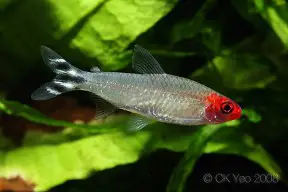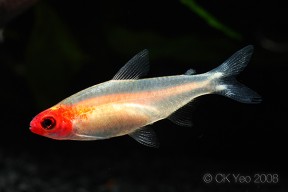Hemigrammus bleheri
Firehead Tetra
SynonymsTop ↑
Hemigrammus bleheri Gery and Mahnert, 1986
Etymology
Petitella Géry & Boutière 1964, from the French –ella, a diminutive connoting endearment; in honor of zoologist-anatomist Georges Petit (1892-1973).
bleheri, honouring the species’ discoverer, Heiko Bleher.
Classification
Characidae: Stethaprioninae
Distribution
Rio Meta and Rio Negro in Colombia and Brazil.
Habitat
Blackwater rivers and tributaries. The water in these biotopes is typically stained brown with tannins from decaying organic material and is very acidic as a result.
Maximum Standard Length
2″ (5cm).
Aquarium SizeTop ↑
This is a species that should be maintained in groups numbering 10 or preferably more, and its active swimming nature requires a tank length of 36 inches/90 cm minimum.
Maintenance
A biotope setup would be very simple to arrange. Use a substrate of river sand and add a few driftwood branches (if you can’t find driftwood of the desired shape, common beech is safe to use if thoroughly dried and stripped of bark) and twisted roots. A few handfuls of dried leaves (again beech can be used, or oak leaves are also suitable) would complete the natural feel. Aquatic plants are not a feature of this species‘ natural waters. Allow the wood and leaves to stain the water the colour of weak tea, removing old leaves and replacing them every few weeks so they don’t rot and foul the water. A small net bag filled with aquarium-safe peat can be added to the filter to aid in the simulation of black water conditions. Use fairly dim lighting. Under these conditions the true beauty of the fish will be revealed.
Alternatively it also does well in a more standard, well-planted tank. A good maintenance regime is essential with this species as it will lose colour in unfavourable conditions. Weekly partial water changes are therefore a must.
Water Conditions
Temperature: 23-26°C (74-79°F)
pH: 5.5-7.0. Its colours will become faded if kept in alkaline conditions.
Hardness: 2-15°H
Diet
Omnivorous and will accept just about anything offered. It does have a small mouth, though, so correspondingly sized foods are best. Feed a mixture of dried flakes and granules and small live and frozen foods. A varied diet such as this is essential for the best colour development.
Behaviour and CompatibilityTop ↑
It’s a very peaceful species that won’t compete well with very boisterous or much larger tankmates. Ideally keep it with other South American species, such as other Hemigrammus or Hyphessobrycon species, pencil fish, Apistogramma dwarf cichlids, Corydoras and small Loricariids. In a more general community it can be combined with smaller rasboras, barbs, Anabantoids and West African dwarf cichlids such as Pelvicachromis species. Many discus enthusiasts keep a shoal of rummy noses in their show tanks, too.
Always buy a group of at least 10 of these, preferably more. They are one of the more tightly shoaling small tetras, and will not do well if kept in insufficient numbers. Because they do shoal so closely, they actually look far more effective when maintained like this anyway.
Sexual Dimorphism
Mature females are noticeably rounder in the body than males.
Reproduction
You’ll need to set up a separate tank in which to do so if you want to raise any numbers of fry. Something around 18″ x 12″ x 12″ in size is fine. This should be dimly lit and contain clumps of fine leaved plants such as java moss or spawning mops, to give the fish somewhere to deposit their adhesive eggs. You could also cover the base of the tank with some kind of mesh. This should be of a large enough grade so that the eggs can fall through it, but small enough so that the adults cannot reach them. It can be spawned in a group, with half a dozen specimens of each sex being a good number. Condition these with plenty of live and frozen foods and spawning should not present too many problems.
Alternatively it can be spawned in pairs. Under this technique the fish are conditioned in male and female groups in separate tanks on a high quality diet of frozen and live foods, at a temperature around 75-78°F. Keep the temperature of the spawning tank a few degrees higher than the main tank, say around 82-86°F, with a pH on the acidic side of neutral. When the females are noticeably full of eggs and the males are displaying their best colours, select the fattest female and best-coloured male and transfer them to the spawning tank. The pair should spawn the following morning.
In either situation the adults will eat the eggs given the chance and should be removed at the first opportunity ie. as soon as eggs are noticed. These will hatch in 24-36 hours, with the fry becoming free swimming a 3-4 days later. They should be fed on an infusoria–type food for the first few days, until they are large enough to accept microworm or brine shrimp nauplii. The eggs and fry are light sensitive in the early stages of life and the tank should be kept as dimly lit as possible.
NotesTop ↑
This is the species most commonly sold as ‘rummy-nose tetra’ in aquatic outlets. A selectively-bred “golden” variant has also been produced by commercial breeders and is available from time-to-time. The natural form is very similar to both the “true” rummy-nose, Hemigrammus rhodostomus and the ‘false’ rummy-nose, Petitella georgiae in appearance. The 3 species can distinguished by several factors.
The first is by the extent to which the red colouration on the head of the fish extends into the body. H. bleheri is the only one of the 3 in which the red extends beyond the gill covers. The amount of red colouration on the other 2 species is comparable, although it tends to be a little lighter in tone in P. georgiae. This factor alone cannot be used to positively identify a species, though, as if the fish are not in good condition the red colour can fade considerably. This is particularly true for H. bleheri.
The second thing we should examine is the caudal peduncle of the fish. All 3 species possess a dark blotch at the top of the caudal peduncle, but only the Hemigrammus possess one at the bottom. If the bottom blotch is absent, you are probably looking at a Petitella.
The third factor to look at is the line extending laterally from the central caudal fin band into the body of the fish. This is quite broad in P. georgiae, narrow in H. rhodostomus and almost non-exisitent in H. bleheri. By a combination of these factors, you should be able to identify your fish. The species differ in a couple of other ways, too, such as the patterning of the caudal fin and at the base of the anal fin.
Like all Hemigrammus, the taxonomic status of this species is currently Incertae Sedis, meaning uncertain. The genus is currently used as something of a catch-all for over 70 species of small characin. Most experts agree that a full revision is required, with the likely outcome that many species will be placed into new or different genera.
Bittencourt, et al. (2020) proposed the transfer of the rummynose tetras Hemigrammus rhodostomus and H. bleheri to the genus Petitella on the basis of molecular and morphological data. Petitella is defined therein as follows:
The genus Petitella is readily distinguished from all remaining characid genera by the possession of a distinctively bright red head, the presence of a black horizontal bar that extends from the end of the caudal peduncle to the middle rays of the caudal-fin, and the presence of an oblique black bar in each caudal-fin lobe, separated by white colored bands. Contact between frontals anterior to frontal fontanel present; posterodorsal margin of ethmoid cartilage and lateral ethmoids distant from lateral ethmoids; 17 or fewer branched anal-fin rays; only one or two anal-fin hooks on each ray of adult males; the presence of parallel longitudinal ridges on the posterior field of scales; scales covering one-third of the length of caudal-fin lobes; coloration of the head distinctively red, especially the snout.
The phylogenetic reconstruction also confirms Petitella georgiae as a sister-group of Petitella bleheri. The striking p-distance divergence (9.1%) between the Peruvian P. georgiae and our samples from the Purus River indicates the possibility of Petitella georgiae being a species complex. The monophyly of P. bleheri and P. georgiae was highly supported in our analyses — the first time Petitella georgiae was included in any molecular phylogeny — as well as by the morphological data of Mirande (2019), who reported seven morphological synapomorphies supporting the sister-taxon relationship between these two species.
Petitella bleheri is distinguished from its congeners by the much more intense and widespread red color of the head, extending up to the humeral region (vs. limited red coloration and not extending to humeral region in P. georgiae and P. rhodostomus); horizontal black bar on the end of the caudal peduncle is never prolonged forward (vs. prolonged up to the anal-fin in P. georgiae and P. rhodostomus); anal-fin hyaline (vs. a black bar on the base of the anterior part of the anal-fin, continuing obliquely on the branched rays in P. georgiae and P. rhodostomus). [Bittencourt, et al. 2020 changed the species epithet rhodostomus to rhodostoma, but the specific name is an indeclinable noun and thus remains rhodostomus (Eschmeyer’s Catalog of Fishes, 2020).]
References
- Géry, J. and V. Mahnert, 1986 - Tropical Fish Hobbyist v. 34 (no. 11): 37, 40-41, 44-45, 48-49, 52
A new rummy-nose tetra from the Rio Negro, Brazil: Hemigrammus bleheri n. sp. (Characidae, Tetragonopterinae), with comments on Paracheirodon. - Bittencourt PS, Machado VN, Marshall BG, Hrbek T, Farias IPF, 2020 - Neotropical Ichthyology 18(2): e190109
Phylogenetic relationships of the neon tetras Paracheirodon spp. (Characiformes: Characidae: Stethaprioninae), including comments on Petitella georgiae and Hemigrammus bleheri. - Mirande, JM, 2019 - Cladistics 35(3): 282-300
Morphology, molecules and the phylogeny of Characidae.



